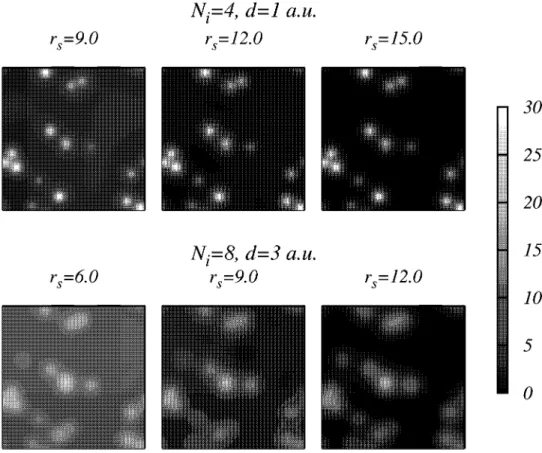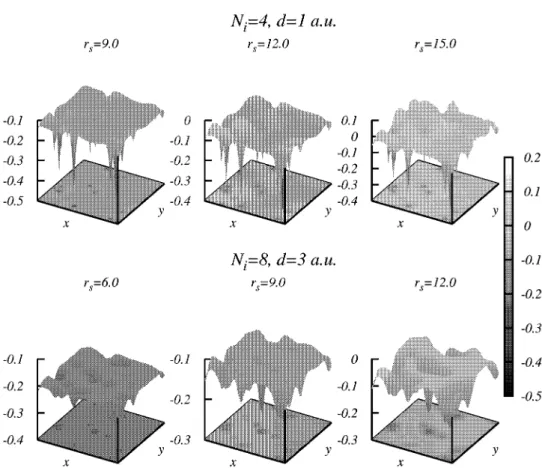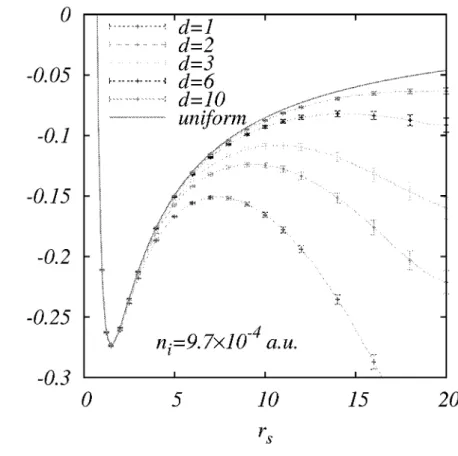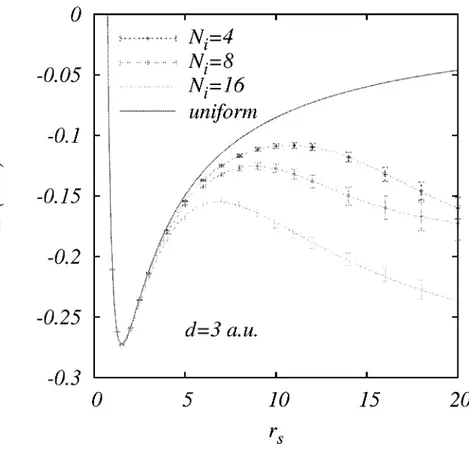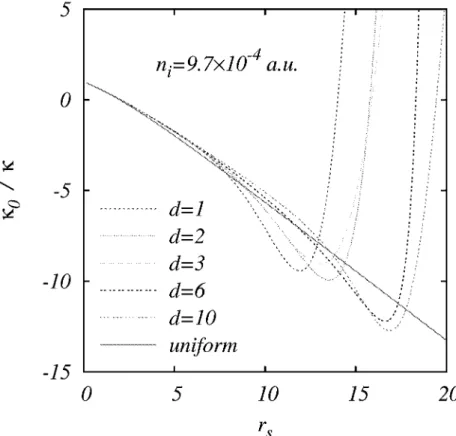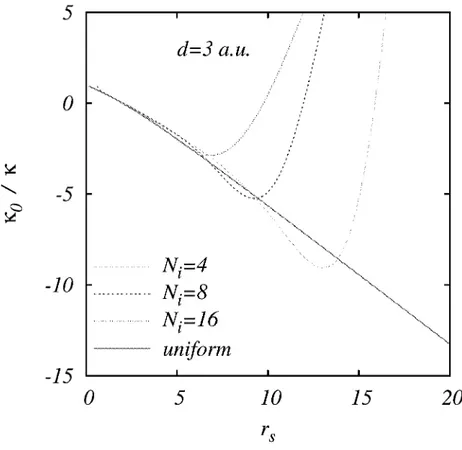Vol. 21, Nos. 13 & 14 (2007) 2134-2144 V i S W°r l d S c i e n t i f i c
_^ ' . T, , ,. , • ^, • ' • www.worldscientific.com (c) World scientific Publishing Company
G R O U N D - S T A T E E N E R G Y A N D C O M P R E S S I B I L I T Y OF A D I S O R D E R E D T W O - D I M E N S I O N A L E L E C T R O N GAS
B. TANATAR* and A. L. SUBA§I Department of Physics, Bilkent University,
Bilkent, Ankara, 06800, Turkey "E-mail: tanatar@fen.bilkent.edu.tr
K. ESFARJANI
Department of Physics, Sharif University of Technology, Tehran, Iran
Department of Physics, University of California, Santa Cruz, CA 95064
S. M. FAZELI
Department of Physics, Sharif University of Technology, Tehran, Iran
Two-dimensional (2D) electron systems in the presence of disorder are of interest in connection with the observed metal-insulator transition in such systems. We use den-sity functional theory in its local-spin denden-sity approximation (LSDA) to calculate the ground-state energy of a 2D electron system in the presence of remote charged impurities which up on averaging provides disorder. T h e inverse compressibility calculated from the ground-state energy exhibits a minimum at a critical density controlled by the disorder strength. Our findings are in agreement with experimental results.
Keywords: 2D electron gas; disorder effects; compressibility.
1. Introduction
There has been an immense amount of experimental and theoretical activity in recent years to understand the ground state properties of two-dimensional (2D) electron systems.1'2 Advances in fabrication techniques have made it possible to probe various quantities of interest in high quality and very low density samples. Most notably, the observation of a metal-insulator transition1'2 in these systems provides a major motivation to study the various physical properties. Most exper-iments perform transport measurements obtaining resistivity or conductivity as a function of temperature at varying electron density to deduce the metallic or in-sulating phases.3'4,5'6 In contrast, Hani et al.7 used the capacitance technique, a
thermodynamic measurement, to measure the compressibility finding that it be-comes spatially inhomogeneous as the density is lowered. Similar observations were also made by Dultz and Jiang8 on a 2D hole system who noted that the inverse
compressibility is minimum at the same density where the metal-insulator transi-tion occurs. Recent compressibility and resistivity experiments by Allison et al.9 on
the same samples indicate that inverse compressibility minimum is not related to metal-insulator transition.
Most of our understanding of metal-insulator transition in 2D electron systems is based on various transport measurements. For instance, experiments at in-plane magnetic field concentrated on the spin susceptibility, Lande ^-factor, and effective mass of the 2D electron systems present in Si-MOSFETS and GaAs quantum-well structures3 , 4'5 , 6'1 0'1 1. In particular, Shashkin et al.12'13 reported a sharp increase
of the effective mass near the critical density at which the system starts to show deviations from the metallic behavior. On the other hand, Pudalov et al.s have found
only moderate enhancement of the spin susceptibility and effective mass in their samples. Thermodynamic measurements of magnetization of a dilute 2D electron system were reported by Prus et al.10 and Shashkin et al.11 Both experiments found
large enhancement of the spin susceptibility \s over its Pauli value. Whereas the
measurements of Prus et al.10 found no indication toward a ferromagnetic instability,
Shashkin et al.11 observed diverging behavior in \s at a critical density coinciding
with the metal-insulator transition density obtained from transport measurements. As indicated above, there are very few thermodynamic measurements at densi-ties around the metal-insulator transition. As recent theoretical work by Punnoose and Finkelstein14 shows the observed behavior in 2D systems suggests an interac-tion driven mechanism with disorder playing an important role. On the theoretical side, calculations of compressibility for a 2D system of electrons in the presence of disorder predict the observed behavior of upturn and divergence15'16. Shi and Xie17 performed density functional calculations based on the (unpolarized) local density approximation developed by Tanatar and Ceperley 18 within the Thomas-Fermi (TF) theory, and found similar results for the compressibility. They also identified the MIT point with the percolation transition point in this system. This was fur-ther developed by Das Sarma et al.19 who measured the critical exponent for the
conductivity and found it in agreement with that proposed by percolation theory. On the other hand, Fogler20 argued against percolation transition by calculating the critical density to be much smaller.
In this work, we investigate the spatial distribution of carrier density and the compressibility of a 2D electron system using the local spin-density approximation (LSDA) both at the TF and Kohn-Sham (KS) levels. The correlation energy func-tional we use is the one constructed by Attaccalite et al.21 from the very recent
quantum Monte Carlo (QMC) calculations for correlation energy appropriate for uniform systems. An important feature of these simulations is that a transition to a ferromagnetic phase at low densities is built in the functional. A disorder potential due to remote impurities is included to make the calculation realistic. The density distribution of the system shows high and low density regions as reported earlier by Shi and Xie.17 Our density functional theory calculations clearly show that the ob-served minimum behavior in inverse compressibility is the result of electron-impurity
interaction. The critical density at which the minimum occurs is controlled by the disorder strength.
In the rest of this paper, we first outline the density functional theory as applied to 2D electron systems with impurity interaction, and introduce our computational method. We then present our results for the ground-state energy and compressibility for 2D electrons in the presence of disorder and discuss our findings in the light of recent experiments.
2. T h e o r y
We consider a 2D electron system interacting via the long range Coulomb interaction whose Fourier transform is Vq = 2ixe2 /(eq) in which e is the background dielectric
constant. The system is characterized by the dimensionless interaction strength
rs = l/{ima*B2)1/2, where n is the 2D electron density and aB = h2e/(m*e2) is
the effective Bohr radius defined in terms of the band mass m* of electrons in the semiconductor structure and dielectric constant e of the material.
Within the spin-density functional theory the total energy of an iV-electron interacting system in a local external potential Vext (r) is a unique functional of spin densities n-[ (r) and n [ (r). The total energy functional can be expressed as
-Erotai K . ni\ = ET [«T ,ni\+EH [nT, n j
+Ex[nhni\ + Ec[nhni\+Eext[nhni\ (1)
We approximate the kinetic energy functional by the Thomas-Fermi-Weizacker (TFW) form given by
ET[nhni\ = ^2 dr \rnl(r)+A^n^
|2"
(2)
JV(r)
with A = 1/822. The direct Coulomb energy is given by
,-, r i e2 f ,9 ,9 / nM n(r') , .
E
H[n
hni} = - J d
2vd
2v'
r ;_ Y (3)
where n(r) = n^(r) + n^(r) is the total density.The exchange and correlation energy functionals within the local spin-density approximation are written as
Ex>c[nhni\ = Id reX ) C(nT(r),ni(r)) [nT(r) + nj,(r)]. (4)
Here ex is the exchange energy of the 2D homogeneous electron electron gas. For
the correlation energy ec we use the recent QMC result of Attaccalite et al.21 again
for the 2D homogeneous electron gas which has been parametrized as a function of density and spin polarization.
N
t=4, d=l a.u.
r=9.0 r=12.0 r=15.0
Fig. 1. Density distributions of a 2D electron system in a model disorder potential for several values of average electron density characterized by rs. The numbers on the right scale are in units
of 1 0 ~3 a.u. We choose the impurity parameters as upper panel: Ni = 4 and d = 1 a.u., lower panel:
Ni = 8 and d = 3 a.u. Ten realizations of the impurity potential are averaged, (colour online)
The disorder studied in this work comes from a random distribution of charged impurities (with charge Ze) at a setback distance d from the electron layer. The energy functional due to the external potential is
£ext[n] = Jd2rVext(v){n(v)} (5)
where the external potential, due to remote impurities, located at ri at a distance
d from the plane of 2D electrons is given by
Tr / N v ^ Ze2/e
V« * « = - E[ ( r_r i )2 + d 2 ]l / 2 - W
3. M e t h o d
The spin-densities n | ( r ) and n^(r) that extremize the total energy functional can be obtained by annealing from a Monte Carlo (MC) simulation. A sufficiently high
--9.0
N
t-4, d-1
a.u.
r=12.0 r=15.0 =6.0 N—8, d=3 a.u. r=9.0 r=12.0 -i 0.2 - 0.1 -] 0 0.1 • -0-2 -0.3 -0.4 -0.5Fig. 2. The effective potential at different disorder strengths and average electron densities char-acterized b y rs. We choose the impurity parameters as upper panel: Ni = 4 and d = 1 a.u., lower panel: Ni = 8 and d = 3 a.u. Ten realizations of the impurity potential are averaged.
temperature is first chosen and a Metropolis Monte Carlo run is performed long enough to reach thermodynamic equilibrium. Then the temperature is reduced and the run is repeated. This is continued until the final temperature is sufficiently low so that very little energy fluctuations occur during the last run. This simulation is done in order to reach the global minimum of the energy landscape. Once one is near the bottom of the valley, eventually a steepest-descent algorithm is applied to reach the minimum energy structure faster. The areal integral of the energy functional is approximated by a discrete sum: basically the density and potentials are discretized on a 64 by 64 mesh whose size is one effective Bohr radius being equal to 100 A in GaAs samples. The long-range Coulomb potential is calculated using the Ewald sum method. In minimizing the total energy functional, if needed, we have considered several different realizations for the impurity atoms and have taken the statistical average.
To make sure of the validity of our analysis, the results from the TFW kinetic energy functional were also compared to the solution of the Kohn-Sham equations
0
-0.05
-0.1
-0.15
-0.2
-0.25
-0.3
d=l
d=2
d=3
d=6
d=10
uniform .^f%
V n-=9.7x10'
4a.u.
0
5
10
15
20
Fig. 3. Ground state energy (per particle) of a 2D electron system in the presence of charged impurities of concentration m = 0.97 x 1 0- 3 a.u. Distance d of the impurities are given in the
legend. Homogeneous system result (solid line) is the QMC calculation of Attaccalite et al. (Ref. 21) where the kinetic energy is calculated exactly. Densities in the high effective po-tential regions were found to agree to within a few percent. Low popo-tential regions showed good agreement between the densities as well as the effective exchange-correlation potential. The Kohn-Sham equations follow from the minimization of the total energy functional under the constraint of fixed total number of electrons. The effective single-particle Schrodinger equation is
[-V2 + Ves(n,r)}^iS(i) = eisi[)iS(r)
where
VeS{n,v)=Vd{v) +
jdx'-8n [ex(n)n + ec(n)n]
(7)
(8) is the effective potential self-consistently determined by the density distribution n(r) = *l2is l'!/,is(r)|2 by summing over the occupied energy levels and the spin index s.
0
r
0.05
0.1
£ 0.15
0.2
0.25
0.3
-0 5 1-0 15 2-0
rsFig. 4. Ground state energy (per particle) of a 2D electron system in the presence of charged impurities at a setback distance d = 3 a.u. Number of impurities are given in the legend. Homoge-neous system result (solid line) is the QMC calculation of Attaccalite et al. (Ref. 21)
We also remark that a similar Hartree-Fock calculation was recently performed on a Mott insulator in the half-filled limit23 where the ground state is antiferro-magnetic. We believe that the exchange-correlation potential we are using is more realistic, and contains the correct physics, namely that at very low densities, before the Wigner crystallization, the system becomes ferromagnetic.
4. Results and Discussion
We have calculated the ground-state energy and corresponding density distribution of a 2D electron system for various impurity potentials characterized by ra» and
d. We use typically 10 different realizations for the impurity potential to calculate
the average value of the physical quantities. Our calculations are carried out in a 64 x 64 discrete space. The size of the system is set as L = 6 4 a | j . The average electron density is adjusted by changing the electron number N. We use atomic units (a. u.) to measure energy and length, i.e. a*B = 1.
N
t=4
N
t=8
N
t=16
uniform
n
{=9.7xl0'
4a.u.
J I L
0 5 10 15 20
rs
Fig. 5. Inverse compressibility scaled by its noninteracting value as a function of re for a 2D electron system in the presence of charged impurities of concentration n , = 0.97 x 1 0- 3 a.u.
Distance d of the impurities are given in the legend. Homogeneous system result (solid line) is the QMC calculation of Attaccalite et al. (Ref. 21)
Illustrative examples of density distributions resulting from the minimization of total energy are shown in Fig. 1 for two sets of (rii,d) values at various average electron densities described by rs. We observe that electrons form high density
and low density regions, an inhomogeneous distribution. Depending on the average density of the system, the high density regions may be connected to each other or form isolated patches. Approaching from the low average density side (large rs) , at some critical density the high density regions start to percolate through the system and form a conducting channel. This may be thought of a demonstration of metal-insulator transition in a 2D electron system as a percolation transition in electron density. Experiments on conductivity19 and resistance and 1 / / resistance noise24 have been analyzed in terms of a percolation scenario. The calculations of Fogler20 and analysis of Allison et al.9 data, on the other hand, suggest otherwise. We have
not performed any systematical analysis of our calculated density distributions in view of percolation transition, thus we are not able to infer any conclusions.
J
0
-5
•10
d=3
a.u.
0 5
10 15 20
rs
Fig. 6. Inverse compressibility scaled by its noninteracting value as a function of rrs for a 2D electron system in the presence of charged impurities at a setback distance d = 3 a.u. Number of impurities are given in the legend. Homogeneous system result (solid line) is the QMC calculation of Attaccalite et al. (Ref. 21)
In Fig. 2 we display the effective potential [c.f. Eq. (8)] including the Hartree, exchange-correlation, and disorder contributions. As is the density distributions we average over 10 realizations of the impurity potential for each rs value. It is seen
that Vefj shows the largest fluctuations when the density distribution is highest. In Fig. 3 we show the ground state energy (per particle) as a function of rs
for different disorder potentials. Here the impurity concentration is kept fixed at n, = 0.97 x 10~3/a*B and the setback distance d from the electron layer is varied. For
large values of d the total energy approaches to that of the homogeneous system.21 This demonstrates the reliability of our numerical approach. We also note that deviations from the clean system result manifest themselves at larger rs values
indicating the importance of interplay between interaction and disorder effects. That is, for the same strength of impurity potential the ground-state energy is more affected at a larger rs value. In Fig. 4 the setback distance is fixed at d = 3 a.u.
J
0
-5
•10
and t h e number of charged impurities is varied. Similar qualitative effects are also observed on t h e g r o u n d - s t a t e energy as t h e disorder s t r e n g t h is increased.
Having calculated t h e ground-state energy for a 2D electron system in t h e presence of disorder, we now t u r n our a t t e n t i o n t o t h e isothermal compressibil-ity 1 / K = (N2/A)d/j/dN where \x = dE/dN is t h e chemical potential. In terms of
t h e noninteracting system compressibility KO we obtain
^
=_rJldE__
rs9^E]
K 4 drs s dr2
where t h e energy E is in a.u. Using t h e ground-state energy curves for a 2D dis-ordered electron system displayed in Figs. 3 and 4, we calculate t h e inverse com-pressibility. Figures 5 and 6 show t h e inverse compressibility as a function of rs for
different disorder strengths. We observe t h a t when impurity scattering is present in t h e system, KQ/K exhibits a m i n i m u m a t some critical rs value, makes an u p t u r n ,
becomes positive, a n d finally diverges a t a larger rs. This qualitative behavior seems
t o be quite general, in t h e sense t h a t even a very weak disorder leads t o it. In a fully interacting system without disorder, on t h e other h a n d , KQ/K is a monotone decreasing function of rs. T h e m i n i m u m of KQ/K is controlled by t h e s t r e n g t h of
electron-impurity interactions and t h r o u g h averaging by t h e disorder strength. Our results for t h e inverse compressibility of a 2D electron system in t h e pres-ence of disorder are in agreement with experimental findings.7'8'9 In particular, t h e
recent experiments of Allison et al.9 performed on a variety of electron a n d hole
systems have shown t h e existence of a m i n i m u m in KQ/'K, occurring quite generally. These experiments have also measured resistivity on t h e same samples a n d showed t h a t t h e metal-insulator transition (determined from dp/dT = 0) is not related to t h e m i n i m u m behavior of KQ/K. W i t h i n our g r o u n d - s t a t e energy based calculations we cannot locate t h e metal-insulator transition density (or corresponding rs). We
expect t h e analysis of t h e solution of K o h n - S h a m equations, for instance t h e statis-tical properties of single-particle energy levels m a y shed some light on this problem which we hope to study in future.
A c k n o w l e d g m e n t s
This work is partially s u p p o r t e d by T U B I T A K a n d T U B A . K. E. would like t o t h a n k T U B A for support a n d t h e hospitality of Bilkent University where p a r t of this work was performed. We t h a n k Dr. M. M. Fogler for discussions. We also dedicate this p a p e r to Professor M. Tomak on t h e occasion of his sixtieth birthday.
R e f e r e n c e s
1. E. Abrahams, S.V. Kravchenko, and M.P. Sarachik, Rev. Mod. Phys. 73, 251 (2001). 2. S.V. Kravchenko and M.P. Sarachik, Rep. Prog. Phys. 67, 1 (2004).
3. V. M. Pudalov, M. E. Gershenson, H. Kojima, N. Butch, E. M. Dizhur, G. Brunthaler, A. Prinz, and G. Bauer, Phys. Rev. Lett. 88, 196404 (2002).
5. J. Zhu, H. L. Stormer, L. N. Pfeiffer, K. W. Baldwin, and K. W. West, Phys. Rev. Lett. 90, 056805 (2003).
6. W. Pan, D. C. Tsui, and B. L. Draper, Phys. Rev. B 59, 10 208 (1999).
7. S. Hani, A. Yacoby, D. Mahalu, and H. Shtrikman, Phys. Rev. Lett. 84, 3133 (2000). 8. C. Dultz and H. W. Jiang, Phys. Rev. Lett. 84, 4689 (2000).
9. G. Allison, E.A. Galaktionov, A.K. Savchenko, S.S. Safonov, M.M. Fogler, M.Y. Sim-mons, and D.A. Ritchie, Phys. Rev. Lett. 96, 216407 (2006).
10. O. Prus, Y. Yaish, M. Reznikov, U. Sivan, and V. Pudalov, Phys. Rev. B 67, 205407 (2003).
11. A. A. Shashkin, S. Anissimova, M. R. Sakr, S. V. Kravchenko, V. T. Dolgopolov, and T. M. Klapwijk, Phys. Rev. Lett. 96, 036403 (2006).
12. A.A. Shashkin, S. V. Kravchenko, V. T. Dolgopolov, and T. M. Klapwijk, Phys. Rev. B 6 6 , 073303 (2002).
13. A. A. Shashkin, M. Rahinii, S. Anissimova, S. V. Kravchenko, V.T. Dolgopolov, and T. M. Klapwijk, Phys. Rev. Lett. 9 1 , 046403 (2003); A. A. Shashkin, S. V. Kravchenko, V. T. Dolgopolov, and T. M. Klapwijk, J. Phys. A: Math. Gen. 36, 9237 (2003). 14. A. Punnoose and A.M. Finkelstein, Science 310, 289 (2005).
15. Q. M. Si and C. M. Varma, Phys. Rev. Lett. 8 1 , 4951 (1998). 16. R. Asgari and B. Tanatar, Phys. Rev B 65, 085311 (2002). 17. J. Shi and X.C. Xie, Phys. Rev. Lett. 88, 086401 (2002). 18. B. Tanatar and D. M. Ceperley, Phys. Rev. B 39, 5005 (1989).
19. S. Das Sarma, M.P. Lilly, E.H. Hwang, L.N. Pfeiffer, K.W. West, and J.L. Reno, Phys. Rev. Lett. 94, 136401 (2005).
20. M.M. Fogler, Phys. Rev. B 69, 121409 (2004).
21. C. Attaccalite, S. Moroni, P. Gori-Giorgi, and G. B. Bachelet, Phys. Rev. Lett. 88, 256601 (2002).
22. Y. Wang, J. Wang, H. Guo, and E. Zaremba, Phys. Rev. B 52, 2738 (1995). 23. D. Heidarian and N. Trivedi, Phys. Rev. Lett. 93, 126401 (2004).
24. G. Deville, B. Leturcq, D. L'Hote, R. Tourbot, C. J. Mellor, and M. Henini, Physica £ 3 4 , 252 (2006).
